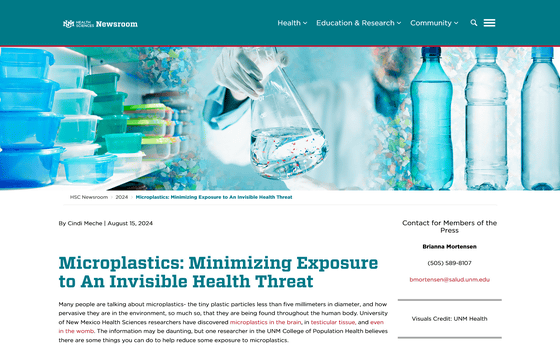How can we minimize our intake of microplastics, which can even find their way into our brains, testicles, and uteruses?

'Microplastics' less than 5 mm in diameter are taken into the body through ingestion of food and water, inhalation of airborne particles, etc. The health risks of ingesting microplastics into the body are not yet clear, but it has been pointed out that there is a potential increased risk of heart disease. The University of New Mexico, which is conducting research on microplastics, introduces ways to reduce the intake of microplastics.
Microplastics: Minimizing Exposure to An Invisible Health Threat

Microplastics are infiltrating brain tissue, studies show: 'There's nowhere left untouched' | Pollution | The Guardian
Modern life is so wrapped up in plastic that it is almost impossible to live without encountering plastic. On average, disposable plastic is thrown away in just 12 minutes, and although it decomposes somewhat after being thrown away, it eventually becomes microplastics and continues to remain in the environment. It is then absorbed into the body via the food chain, inhalation of particles, and skin contact.
Previous studies have found microplastics in the lungs ,blood , placenta , testicles , and even the brain .
Microplastics are not filtered out by water treatment plants, and plants do not have the ability to process them, so they do not absorb them from the environment.
The health effects of microplastics are not yet clear, but evidence suggests they may cause oxidative stress, neurotoxicity, reproductive toxicity, alterations in immune and endocrine function, and an increased risk of heart disease.
For this reason, Dr. Claudia Pratesi, who has been researching plastics in the environment for 10 years at the University of New Mexico College of Public Health, lists ways to reduce the intake of microplastics in our daily lives.
・Drink tap water
If you have a choice, tap water is better than bottled water, and if you have access to a water purifier, you can further remove some of the plastic.
・Avoid heating in plastic containers
Heating food or drinks in plastic containers can cause chemicals to leach into the food, so it's better to use glass or ceramic containers instead.
It turns out that heating plastic food containers in a microwave releases a huge number of plastic particles - GIGAZINE

Use safe storage containers
It is recommended that storage containers be made of glass, ceramic, or stainless steel rather than plastic.
Choose natural foods
Canned foods, junk foods, and processed foods are often exposed to plastic during processing and packaging, so it's better to eat fresh, natural, and minimally processed foods.
-Purchase food from local producers
Eat fresh fruits and vegetables and avoid meats packaged in plastic.
・Avoid products with specific recycling codes
'3: PVC (polyvinyl chloride)' contains phthalate esters, which are carcinogenic, and '6: PS (polystyrene resin)' contains styrene, which affects the central nervous system, so it is better to avoid them. In Japan, different identification labels are used.
Related Posts:
in Science, Posted by logc_nt






